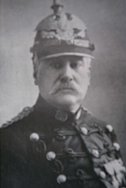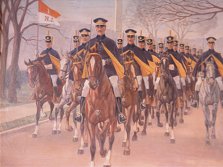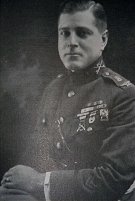Essex Troop
(110th Reunion Press Release & History)
COL (ret) Frank L. Carlone
Essex Troop to Celebrate 110 Years
Tuesday, February 15, 2000
This press release was originally prepared by COL (ret) Frank L. Carlone)
for the 100th Reunion of THE ESSEX TROOP, held in 1990 It is a compilation
of several documents including excerpts from General Eisenhower's book
"Crusade in Europe" and the original "History of the Essex
Troop" published in 1925. It has been adapted to accommodate the
I10th Reunion.
The historic ESSEX TROOP Association, of West Orange, N.J. will muster
its members for their 110th Reunion Banquet at the Mayfair Farms, also
in West Orange, on Saturday, October 28,2000.
The "Root History" of the Essex Troop dates back to the year
1756 when the declaration of the French and Indian War inspired the organization
of the "First Troop of Essex Horse". After service in that war,
the "Essex Cavalier" was never totally absent from the scene,
having taken part in several battles and skirmishes during the War of
independence and the War of 1812.
Later, as part of the "First Regiment Cavalry (N.J. Volunteers)",
organized in July of 1861, Essex Cavaliers fought throughout the Civil
War. After taking part in 96 combat engagements as part of the Army of
the Potomac, including Lee's surrender at Appomattox, the Regiment was
mustered out of Federal Service on July 24, 1865.
The actual formation of THE ESSEX TROOP, as it is now known, was due
to an unexpected occurrence twenty-five years later.
 In May
1890, Colonel James E. Fleming, a Civil War Veteran, was chosen Grand
Marshal of a parade to mark the unveiling of the Seth Boyden statue in
Washington Park, Newark N.J. On the night but one before the ceremonies,
Colonel Fleming was advised that due to a misunderstanding, the aides
and staff he had selected from members of the local trade organizations
would not be available. That same night Colonel Fleming sent out a call
to each of 12 particular members of the Essex Club, in Newark, requesting
that they meet him the next day at the park, suitably mounted to act as
an escort for the parade speaker and other dignitaries. All twelve men
responded and the Parade was carried off splendidly. In May
1890, Colonel James E. Fleming, a Civil War Veteran, was chosen Grand
Marshal of a parade to mark the unveiling of the Seth Boyden statue in
Washington Park, Newark N.J. On the night but one before the ceremonies,
Colonel Fleming was advised that due to a misunderstanding, the aides
and staff he had selected from members of the local trade organizations
would not be available. That same night Colonel Fleming sent out a call
to each of 12 particular members of the Essex Club, in Newark, requesting
that they meet him the next day at the park, suitably mounted to act as
an escort for the parade speaker and other dignitaries. All twelve men
responded and the Parade was carried off splendidly.
Following the ceremonies, the horsemen re-assembled at the Essex Club
for luncheon and after some conviviality and libation, they determined
to form a Troop of Cavalry so as to continue to take part, in Newark's
civil and social events, as a mounted unit. That very afternoon, Colonel
Fleming drew up and had printed 50 copies of a call for a meeting to consider
organizing such a body. The meeting was held on June 3rd, 1890, and of
more then 50 attending, over 40 members of the Essex Club and Roseville
Riding Academy signed the original muster roll of the "Essex Troop,
Light Cavalry".
The Troop remained a private organization until May 17,1893, when as
a result of its splendid reputation, and at the invitation of the Governor,
the Troop was mustered into the New Jersey National Guard. At the insistence
of the Troop, the legislation included wording that would enable the Troop
to retain its associate and honorary members though they could not become
members of the National Guard. The legislation passed both houses without
amendment but later met with some opposition from the State Military Board,
which later realized they were no match to oppose these Troopers. Thus,
the distinction between the military and fraternal aspects of the organization.
In the latter part Of 1894 it was decided definitely that a Troop Armory
was needed. When the Troop grew weary of the State dragging its heels
on the matter, options were obtained on the Roseville Riding Academy and
adjacent properties. By March of 1897 the Troop had its own quarters,
at a cost of about $50,000. The funds were raised from subscriptions from
members and friends of the ESSEX TROOP Association after a fund raising
luncheon at the Essex Club, in Newark.
By 1903 the Troop outgrew its privately owned armory and sought legislation
for the State to build them a new home. When the state again balked, the
Troopers decided (after a luncheon at the Essex Club to discuss the matter)
to sell the old Armory property to the State for $35,000. With this sum
the trustees were authorized to pay the mortgage, purchase land and build
stables on land next adjoining the new State building. Thus, the new Armory
was State owned, while the title to the land and that part of the building
dividing the Grill-room from the Armory proper, including the stables,
remained with the Trustees of the ESSEX TROOP. This proved an asset in
that by its private operation of the grill-room and by rental of some
of the stables, the Troop was able to reduce the burden of the always
heavy costs of hay, oats and grain. Luncheon at the ESSEX TROOP Grill-
Room became almost as colorful and prestigious as luncheon at the Essex
Club.
 One
of the most colorful experiences of the Troop occurred when it was chosen
as personal escort to former governor Woodrow Wilson of New Jersey, upon
his inauguration as President of the United States on March 4, 1913. A
beautiful oil painting of the mounted Troop, depicting this event, now
hangs above the fireplace in the grill-room of the ESSEX TROOP Armory
in West Orange. One
of the most colorful experiences of the Troop occurred when it was chosen
as personal escort to former governor Woodrow Wilson of New Jersey, upon
his inauguration as President of the United States on March 4, 1913. A
beautiful oil painting of the mounted Troop, depicting this event, now
hangs above the fireplace in the grill-room of the ESSEX TROOP Armory
in West Orange.
In 1916, the Troop was mustered for Federal Service along the Mexican
Border and then again in 1917 for World War I. The Troop was honored for
its service at Alsace and the Meusse-Argonne offensive, and was mustered
out of Federal Service in July 1919. The ranks of the association remained
rather stable but the Military organization suffered some loss.
 In
October 1919, Captain Lewis B. Ballantyne, of Newark, decided to revive
the organization and was authorized by the Governor to form one Squadron
of Cavalry. Thus the organization became known as the First Cavalry (ESSEX
TROOP), N. J. N. G. In
October 1919, Captain Lewis B. Ballantyne, of Newark, decided to revive
the organization and was authorized by the Governor to form one Squadron
of Cavalry. Thus the organization became known as the First Cavalry (ESSEX
TROOP), N. J. N. G.
One of the most serious obstacles for Captain Ballantyne to overcome
was meeting all provisions of certain National Guard Regulations in order
to receive national or state funding. The lack of official funding became
a matter to be discussed over a meal, and again, the usual conviviality,
libation and fellowship produced a band of men determined to be of continuing
service to their community, state and nation, no matter what the cost.
With their usual espirit, and at Ballantyne's example, the Troopers again
decided to donate their own funds for the purchase of weapons, horses,
uniforms and all manner of equipage needed for training. In 1920, the
ESSEX TROOP Association purchased 44 acres of land in West Orange, N.J.,
which would be fitted with facilities for a target range, a mounted pistol
course, a standard saber qualification course and pasture where debilitated
horses could recuperate. As a result of his stern and deliberate leadership,
Ballantyne rose rapidly through the ranks to Brigadier General.
On August 17,1921, almost 100% manned by ESSEX TROOP Association members,
the First Cavalry, N. J. N. G. was redesignated with full Federal Recognition
as the 102nd Regiment, Cavalry (ESSEX TROOP).
The ESSEX TROOP Armory in West Orange now sits on 30 acres of land deeded
by the association to the state of New Jersey for the explicit purpose
of construction of the Armory. The architect was an Essex Trooper and
when the outer construction was completed, the Troop provided all internal
furnishings including the bar and grill, the lighting fixtures, the fireplace
and it's fixtures, the Italian marble crest in the lower vestibule, all
paintings and other fixtures and memorabilia.
When not engaged in training, the Troop conducted Horse Shows and Polo
Matches, at both the Newark and West Orange Armories. Almost to a man,
during the 1920's and through the 1930's, the horsemen of the ESSEX TROOP
association gained national recognition for their accomplishments in the
Equestrian Arts and by winning several championship rifle and pistol matches
and Polo Trophies. Their dual role as cavalrymen and equestrian sportsmen
continued for more than 20 years.
On January 6,1941, the 102nd Cavalry Regiment (ESSEX TROOP), with elements
from Newark, West Orange and Westfield, N.J. was mobilized into Federal
Service in preparation for World War II. Shortly after mobilization the
Troopers traded their horses for tanks and underwent extensive and specialized
training at Fort Jackson, South Carolina.
After taking part in the "Carolina Maneuvers". the Regiment
was split with the 2nd Squadron embarking for combat in North Africa.
The Squadron was later redesignated the 117th Mechanized Cavalry Reconnaissance
Squadron. The remainder of the Regiment embarked for England and was the
first Cavalry Regiment to arrive there in preparation for the Normandy
Invasion.
In June 1944, two Squadrons, (102nd and 38th) of the Regiment took part
in the landings at Normandy as part of General Eisenhower's "Largest
Armada In History". Shortly after the intense combat of "D-DA
V", 6 June 1944, the Allied advance was slowed and then stopped by
a barrier known as the "Normandy Hedgerows". These centuries
old obstacles consisted of rows upon rows of massive banks of earth, loaded
with heavy stones and covered with thick shrubbery and small trees. The
hedgerows ranged from 6 feet to 27 feet in height.
As each tank attempted to penetrate a hedgerow, it was forced to climb
almost vertically, thereby exposing the unprotected underbelly of the
tank to any kind of armor piercing ammunition. With the tank snout thrust
upward it was impossible to bring their guns to bear on the enemy. Tank
crews were helpless to defend themselves and the German soldiers, hiding
behind the hedgerows would "pick them off' as they tried to get out
of their crippled tanks.
At the direction of the Commander, the Regimental Executive Officer
called a meeting of the Officers and higher-ranking Non Commissioned Officers
and explained the problem. "Gentlemen, I want you to put your thinking
caps on and come up with a solution," he said. This was certainly
a matter suitable for "discussion over lunch" but this time
there was no "Gentlemanly Brunch". There was some Army Chow
that might be ingested between rounds of incoming artillery, and though
the espirit de corps was high, this was no time for the traditional conviviality
and libation.
Within hours of being presented with the challenge, several of the Troopers
came up with the classic solution. Their idea was to head back to the
landing area and gather up some of the large steel angle irons that had
been strewn about the beach by the Germans. These massive pieces of steel,
which would rip through the belly of any tank passing over them, had been
strategically placed there in an effort to prevent a successful landing
of the Allied Forces. The Troopers' suggestion was to retrieve a sufficient
number of the angle irons, to cut them up and reassemble them, and mount
them in a new configuration to the front of several of the Regiment's
Tanks. They would be mounted in such a way so as to permit the tanks to
"Cut Through" rather than to ride over the hedgerows. The Troopers
labeled their device "The Rhino Plow".
Upon personally inspecting the "Rhino Tank", as it came to
be known, General Omar Bradley ordered the highest secrecy regarding it's
nature and purpose so that its initial use against the enemy would be
a complete surprise.
The success of the "Rhino Plow" was immediate. Each especially
equipped tank opened a clearing in the hedgerows large enough for men
and equipment to rush through. In 1948, The Army Times credited the device
as "One of the most important products of G. I. ingenuity during
the entire World War 1/, one which probably saved more American lives
and kept more American tanks in operation than any other single development".
That thrust through the hedgerows gained its own significance in the history
of the Normandy Invasion, with several historical documents referring
to the battle as "Operation Cobra, Breakthrough At Normandy".
The "Rhino Plow" was credited as the single, most important
piece of apparatus contributing to the achievement.
After distinguishing itself at Normandy the Regiment went on through
Europe, taking part in several engagements. Its World War II battle honors
include Normandy (with arrowhead), Northern France, Ardennes-Alsace, Rhinehard
and Central Europe. The Westfield ESSEX TROOPERS (117lhCavalry Reconnaissance
Squadron) also earned a distinguished combat record and their battle honors
include engagements through North Africa, Sicily, Italy and Austria. In
particular, the unit spearheaded the invasion of Southern France, and
was one of the first American units to reach the Rhine with the 71h Army.
The 1171h has the distinction of serving with 21 Divisions. The Regimental
unit decorations includes the Croix de Guerre, with palm, for the beaches
of Normandy.
The 102nd Cavalry Regiment (ESSEX TROOP) is believed to be the only
outfit in the United States Army whose units took part in both the Liberation
of Paris and the Liberation of Rome. While one element of the Regiment
entered Paris, another element was entering Rome, almost on the very same
day.
More than half a century has passed now, since the former horse soldiers
landed on the beaches of North Africa and Normandy, and the 102nd Cavalry
Regiment (ESSEX TROOP), an outfit credited with more days "On The
Line" than any other American Cavalry Unit, no longer exists. The
Regimental Colors have been retired and even the old Essex Club, the original
"Watering Hole" is gone.
But today, with several Historical Markers at Fort Jackson South Carolina,
and with portions of the Patton Museum at Fort Knox, Kentucky dedicated
to its memory, to the Espirit de Corps of the Regiment, and to the men
who preceded the Regiment, THE ESSEX TROOP, still prevails.
The traditions are kept alive by the members of the ESSEX TROOP Association
at the Armory in West Orange, New Jersey and by the members of the 1171h
Cavalry Association at the Westfield, New Jersey Armory. The two associations
work closely together, with a combined nationwide membership of over 1000
veterans of all wars of the United States as well as active members of
the New Jersey National Guard.
With Essex Troopers from all over the world expected to attend, the
schedule of events for the 110th Reunion is still in the planning stages.
It is expected however, that shortly after the event, a call will be put
forward for the Officers and Trustees to begin planning for the 115th
Reunion, to be held 5 years hence, in the year 2005. Certainly a matter
for discussion, over a "Gentlemanly Luncheon".
|
